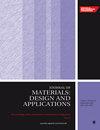基于废水培养的 Sorokiniana 小球藻的碳存储结构材料
IF 2.2
4区 材料科学
Q3 MATERIALS SCIENCE, MULTIDISCIPLINARY
Proceedings of the Institution of Mechanical Engineers, Part L: Journal of Materials: Design and Applications
Pub Date : 2024-09-05
DOI:10.1177/14644207241281707
引用次数: 0
摘要
微藻培养是一项前景广阔的碳封存和废水修复技术。为生产的大量生物质找到可行的应用领域,在经济和物流方面都至关重要。在目前的研究中,一种结构材料是利用几乎 100% 的小球藻开发的。首先对原本不具粘性的微藻细胞进行表面活性处理,然后在相对较高的压力下进行压实。这样得到的材料是一种致密的固体,在抗弯试验中比典型的钢筋混凝土更坚固。处理过程简单快捷,装置可扩展。这项技术可用于下一代绿色建筑,并为可持续微藻生物质提供了一个使用案例。本文章由计算机程序翻译,如有差异,请以英文原文为准。
Carbon-Storing Structural Material Based on Wastewater-Cultivated Chlorella Sorokiniana
Microalgae cultivation is a promising technology for carbon sequestration and wastewater remediation. It is economically and logistically critical to find viable applications for the large quantities of produced biomass. In current research, a structural material is developed by using nearly 100% Chlorella sorokiniana. The otherwise non-cohesive microalgae cells are first surface-activated and then compacted under a relatively high pressure. The resulting material is a dense solid, stronger than typical steel-reinforced concrete in flexural tests. The processing procedure is simple and fast, and the setup is scalable. This technique may be useful for next-generation green construction and provide a use-case for sustainable microalgae biomass.
求助全文
通过发布文献求助,成功后即可免费获取论文全文。
去求助
来源期刊

CiteScore
4.70
自引率
8.30%
发文量
166
审稿时长
3 months
期刊介绍:
The Journal of Materials: Design and Applications covers the usage and design of materials for application in an engineering context. The materials covered include metals, ceramics, and composites, as well as engineering polymers.
"The Journal of Materials Design and Applications is dedicated to publishing papers of the highest quality, in a timely fashion, covering a variety of important areas in materials technology. The Journal''s publishers have a wealth of publishing expertise and ensure that authors are given exemplary service. Every attention is given to publishing the papers as quickly as possible. The Journal has an excellent international reputation, with a corresponding international Editorial Board from a large number of different materials areas and disciplines advising the Editor." Professor Bill Banks - University of Strathclyde, UK
This journal is a member of the Committee on Publication Ethics (COPE).
 求助内容:
求助内容: 应助结果提醒方式:
应助结果提醒方式:


